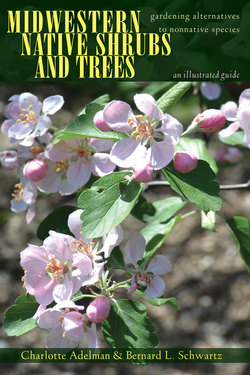Читать книгу Midwestern Native Shrubs and Trees - Charlotte Adelman - Страница 9
На сайте Литреса книга снята с продажи.
ОглавлениеPREFACE
HAVING A YARD or garden enables almost every homeowner, gardener, and landscaper to create a beautiful, low-maintenance native plant sanctuary that sustains native wildlife. Midwestern native plants and birds, butterflies, and bees co-evolved and need each other for a healthy future. The Midwestern Native Garden: Native Alternatives to Nonnative Flowers and Plants discussed native herbaceous plant alternatives to Eurasian introductions and nativars (cultivars of native plants). Remembering landscaping mistakes we had made, we noted in the preface to that volume, “Because we love birds, we lined our borders with berry- and fruit-producing trees and shrubs. Later, to our horror, we discovered that most of our well-meaning plant choices were not native to North America and that some were invasive pests. We realized we had made choices without first getting good information.” This book continues the work of the first volume by providing reliable information for midwestern native alternatives to nonnative trees and shrubs.
When we speak of butterflies, flowers usually come to mind, but “woody plants support more butterfly caterpillars than herbaceous plants.”1 As a group, native trees and shrubs excel as host plants for butterflies and moths, whose larvae or caterpillars “are disproportionately valuable sources of food for many terrestrial birds, particularly warblers and neotropical migrants of conservation concern.”2 What makes native woody plants invaluable to wildlife? “Plants have evolved over time alongside the insect and animal populations that feed and reproduce on them, so planting a variety of plants native to your area is one of the simplest ways of helping out your local wildlife. But . . . on the whole, woody plants like trees and shrubs provide food and shelter to the greatest variety of wildlife. So when choosing where you can have the most impact for your local wildlife, shrubs and trees can be a better bet than perennials and small flowers.”3
As someone who likes to walk and look, I often wander around my neighborhood, observing the local landscaping. Large trees have been replaced by new homes and large garages. Eurasian burning bush, saucer magnolia, dwarf Korean lilac, Japanese lilac tree, winter creeper, and common boxwood are ubiquitous, but they don’t attract butterflies, bees, or birds. Butterflies are rare, goldfinches are scarce, and migrating birds have become uncommon. Scientific data substantiate the decrease of these once abundant wild creatures.4 “The songbirds that brighten spring mornings have been in decline since the 1960s, having lost 40 percent of their numbers so far,” writes entomologist and ecologist Douglas Tallamy. These losses are due “to a host of factors but mainly to habitat loss, which includes displacement of native plants by aliens. The worst invaders are Asian and European.”5
“Homeowners and developers alike are beginning to appreciate the environmental, economic and aesthetic benefits of natural landscaping,” according to the US Environmental Protection Agency.6 Horticulturists and naturalists provide an explanation for this trend: “Today, there is renewed interest in ‘going native’ and restoring diversity to our landscapes by choosing native plants. The reasons for this are many and varied. Planting a native plant provides habitat for a variety of native wildlife species such as songbirds and butterflies. Including native species provides a historical sense of pride to a gardener who grows a plant that Native Americans or early pioneers valued. Furthermore, regionally-adapted native plants have developed a natural resistance to regional pests, and a tolerance to drought, ice storms and other environmental extremes common to the area.”7 Midwesterners with questions about native plants can readily find answers. Typing words like “native plant” into an Internet browser produces helpful information. Organizations and books devoted to birds, butterflies, pollinators, gardening with native plants, native plant nursery catalogs, and our own observations provide information and inspiration to advance the trend toward “natural landscaping.” For more information, please see Selected Bibliography and Resources.
“Now is the time to get started because time is not on our side as more of our native habitats disappear.”8 Regardless of the location or the size of our property, native plants create habitats and migration corridors for wildlife. Even small urban patches can be lifesavers for pollinators (butterflies, moths, bees, beetles, bats, ruby-throated hummingbirds), insect-eating migrating warblers, and other birds that fly from place to place.9 Plantings of thoughtfully chosen and responsibly cared-for native woody and herbaceous species help prevent harm and ensure maximum benefits.
“Planting natives in small landscapes will not recreate ancient ecosystems, but it does create biodiversity to support what’s left of our wildlife,” states Douglas Tallamy, who suggests keeping lawn for where we walk or use it for recreation. “The rest of the landscape would consist of bunching grasses, shrubs, understory trees and canopy trees.”10 Simply by replacing portions of our lawns with native trees, shrubs, and herbaceous species, we can greatly improve home and neighborhood ecosystems.11 Sharing information about the importance of natives and how to choose and purchase them helps create change. Whether by small incremental steps or by big landscaping projects, each of us can decide to help ensure a future for butterflies and birds by choosing life-giving native shrubs and trees.
Homeowners, gardeners, and landscapers have the ability and opportunity to make good environmental choices and to create beautiful landscapes and gardens. And that is something to celebrate. We wrote this book to bring wider attention to the age-old connection between native woody plants and native wildlife. We hope the information we share will intrigue and inspire readers to protect this delicate balance by emphasizing native midwestern woody plants when landscaping and gardening.
